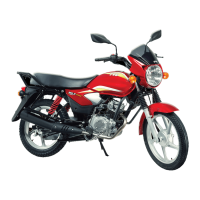WARNING
SAFE RIDING RECOMMENDATIONS
Any two wheeler riding requires some precautions to
be taken to ensure the safety of the rider, pillion rider
and other road users. These precautions are:
Riding apparel
Loose, fancy clothing can be uncomfortable and
unsafe when riding a two-wheeler. Choose good
quality two wheeler riding apparel.
Familiarise yourself with new TVS StaR HLX 150
Riding skill and your mechanical knowledge form the
foundation of safe riding practices. We suggest you
to practice riding in a low-traffic condition until you
are thoroughly familiar with your vehicle and its
controls. Remember perfect practice makes you
perfect.
Two wheeler safety equipment starts with a safety helmet of
good quality. One of the most serious injuries that can
happen is a head injury. Always wear good quality helmet.
You should also have good suitable eye protection.
Know your limits
Ride within the boundaries of your own skill at all times.
Knowing these limits and staying within them will help you
to avoid accidents.
Posture
Proper vehicle riding starts with proper posture.
1. Keep your elbows inside close to the body and kept
flexible.
2. Hold your arms at an angle of about 120°.
3. Hips should be in a position so that arms and shoulders
are relaxed.
4. Look widely instead of gazing at one point.
5. Relax to guard against a sudden impact.
6. Hold the tank tightly with knees.
7. Point the toes straight ahead.
Cornering
When cornering, centrifugal force works in a direction
perpendicular to the direction in which the vehicle is
moving.
Centrifugal force increases in proportion with speed and
shorter the radius of the corner, the greater it becomes.
During cornering, reduce speeds so as to lessen the effects
SAFE RIDING TIPS
SAFE RIDING TIPS
4

